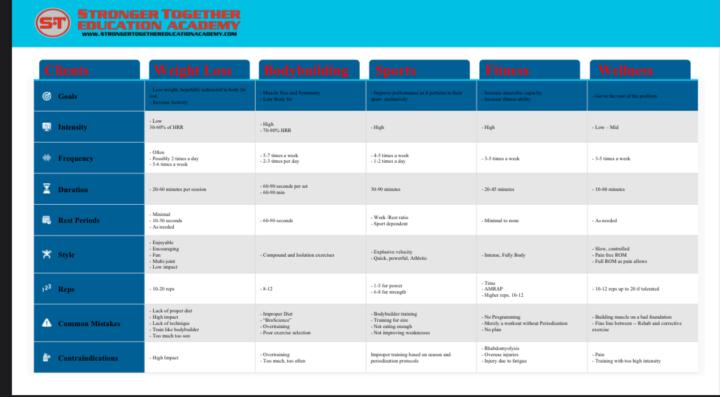🏋️♂️ The 5 Fitness Types – Which One Fits Your Goals?
Understanding why you’re training helps you train smarter. Here are the 5 key fitness paths we explore together: 1. Weight Loss – Focused on burning fat, building healthy habits, and developing a leaner, more energetic body through smart nutrition and training. 2. Bodybuilding – All about muscle growth, symmetry, and definition. This training style emphasizes structure, discipline, and progressive overload. 3. Sports Performance – Built for athletes who want to move faster, jump higher, and react quicker with power, agility, and explosive strength. 4. Fitness & Wellness – Focused on long-term health, movement quality, and daily strength. Great for those wanting to stay fit, active, and injury-free for life. 5. Corrective Training – Designed to fix imbalances, improve posture, reduce pain, and restore proper movement. Perfect for recovery, injury prevention, or starting from the ground up. 💡 Each path requires a different plan—but they all lead to a stronger, more confident you. Inside our community, we help you identify the right track, build your plan, and stay consistent with expert guidance and support.
0
0

16 week Physical Literacy Development Curriculum: Middle and High School
Stronger Together Family (STF) 16-week PE curriculum: Introduction and Purpose At Stronger Together Family, our mission is to help families build stronger, healthier kids who thrive physically, mentally, and emotionally. This 16-week curriculum is designed to develop foundational physical literacy skills—strength, balance, stability, flexibility, movement, and targeting. These skills not only enhance physical fitness but also improve coordination, confidence, and overall well-being. The program includes evidence-based methods that align with PE standards, offering a clear progression from foundational movements to advanced physical skills. It’s ideal for homeschool families, microschools, and anyone aiming to raise well-rounded, healthy kids. Weekly Breakdown Weeks 1-4: Foundational Skills – Building Stability and Balance Focus: Basic movement patterns, posture, and balance awareness. Activities: • Single-leg stands using a balance pad • Gentle yoga stretches on a stretching mat • Stability drills with stepping stones Equipment: • Stretching Mats • Balance Pads • Stepping Stones Research Notes: Studies show balance training improves proprioception and prevents injuries in kids. Weeks 5-8: Developing Strength and Movement Control Focus: Core strength and controlled movement. Activities: • Resistance band exercises for arms and legs • Core strength training with a soft medicine ball • Walking lunges with light hand weights Equipment: • Resistance Bands • Soft Medicine Balls • Hand Weights Research Notes: Strength-building exercises improve bone density and motor control, especially in growing children. Weeks 9-12: Enhancing Flexibility and Targeting Skills Focus: Stretching for flexibility and targeting activities for coordination.
2
0
16 Week Physical Literacy Special Needs Development Curriculum
Introduction and Synopsis Purpose of the Curriculum: This 16-week curriculum is designed to support children with autism and cerebral palsy in developing critical physical, cognitive, and motor skills through movement-based activities. It aligns with the goals of the ESA program in Arizona, emphasizing personalized, inclusive, and evidence-based approaches to physical literacy, strength, and skill development. The program incorporates activities that foster physical growth, improve cognitive function, and build confidence in movement, tailored to the unique needs of each child. By addressing foundational skills like balance, coordination, and strength, it provides a pathway for children to enhance their quality of life and independence through active engagement. Key Goals: 1. Promote physical literacy by teaching fundamental movement patterns. 2. Build strength and stability to improve motor control and reduce spasticity. 3. Enhance cognitive function through movement-based problem-solving and focus activities. 4. Develop functional skills that support daily activities and recreation. Structure Overview: The curriculum progresses across four stages: foundational movements, strength-building, cognitive skill integration, and comprehensive skill application. Each stage builds on the last, offering adaptable exercises to meet the individual needs and abilities of children with autism and cerebral palsy. The program concludes with a detailed assessment of progress and a curated equipment list to support ongoing practice at home or in a therapy setting. Research notes included throughout reinforce the benefits of movement for special-needs children, grounding the curriculum in proven methodologies. This curriculum is more than a physical fitness plan—it’s a holistic tool to help children thrive physically, mentally, and emotionally. Week-by-Week Outline 1. Weeks 1-4: Foundation of Physical Literacy and Basic Movement Skills • Objectives: Introduce and assess basic movements like walking, reaching, and balance.
1
0
Strength Training Rubric:
A rubric for strength training and fitness assessments serves as a structured tool to evaluate performance based on clear, measurable criteria. It allows us to assess both objective factors—such as proper form, number of repetitions, or improvement in strength—and subjective aspects like effort, consistency, and motivation. By breaking down these components, we can fairly evaluate each student’s progress and performance. The rubric ensures all participants are assessed equally, providing a transparent standard for success while offering detailed feedback on areas for growth in both physical ability and personal effort. https://docs.google.com/file/d/1eiz_LICE5wHZcuJsxnMTTEcR7CfGLUjs/edit?usp=docslist_api&filetype=msword
1
0
Stability Rubric
A rubric is a tool that helps us assess students’ performance by providing clear criteria for both subjective and objective evaluation. It outlines specific expectations and breaks down tasks into measurable components, allowing us to grade consistently across all students. By using a rubric, we can objectively measure factors like completion and accuracy, while also subjectively evaluating qualities like creativity or effort. This ensures a fair and standardized way to assess everyone equally, making expectations transparent and providing constructive feedback for improvement. This rubric is for Stability https://docs.google.com/file/d/17IFjfBUllGUIVKhimacIaVCYIZNPtoIF/edit?usp=docslist_api&filetype=msword
2
0
1-5 of 5
powered by

skool.com/stronger-kids-brighter-future-8689
Your go-to resource for anyone striving to raise healthy, fit kids with daily tips, training and expert guidance on fitness, nutrition and wellness
Suggested communities
Powered by

